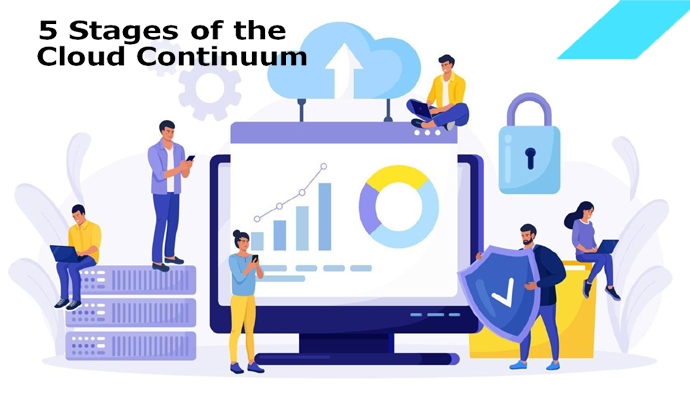Download PDF
Introduction
The Cloud Continuum: Understanding the Different Types of Cloud Computing. As organizations continue to adopt cloud computing, it’s becoming increasingly important to understand the different types of cloud and how they can be used to meet different business requirements. This is where the Cloud Continuum comes in. The Cloud Continuum is a framework that helps organizations understand the different types of cloud computing and how they can be used to meet different business requirements.

The Cloud Continuum consists of five stages: On-Premises, Public Cloud, Private Cloud, Hybrid Cloud, and Multi-Cloud. Each stage represents a different level of cloud adoption, from traditional on-premises infrastructure to a fully integrated multi-cloud environment. In this blog post, we’ll take a closer look at each stage of the Cloud Continuum and explore the benefits and drawbacks of each.
On-Premises

The Cloud Continuum consists of five stages: On-Premises, Public Cloud, Private Cloud, Hybrid Cloud, and Multi-Cloud. Each stage represents a different level of cloud adoption, from traditional on-premises infrastructure to a fully integrated multi-cloud environment. In this blog post, we’ll take a closer look at each stage of the Cloud Continuum and explore the benefits and drawbacks of each.
Public Cloud

The next stage of the Cloud Continuum is Public Cloud. This is where organizations use cloud computing services provided by a third-party provider, such as Amazon Web Services, Microsoft Azure, or Google Cloud Platform. Public cloud providers offer a wide range of services, including computing, storage, and networking, as well as specialized services like databases and analytics. The main advantage of this model is that organizations only pay for the resources they use, and they don’t have to worry about the underlying infrastructure.
Private Cloud

The third stage of the Cloud Continuum is Private Cloud. This is where organizations use cloud computing services that are provided by a third-party provider, but the underlying infrastructure is dedicated to a single organization. This can include both hardware and software. The main advantage of this model is that organizations have more control over their IT infrastructure, and they can customize it to meet their specific needs. Additionally, private clouds can be more secure than public clouds, as the infrastructure is not shared with other organizations.
Hybrid Cloud

The fourth stage of the Cloud Continuum is Hybrid Cloud. This is where organizations use a combination of public and private cloud services. This can include using a public cloud provider for non-sensitive workloads while using a private cloud for sensitive workloads. The main advantage of this model is that organizations can take advantage of the cost savings of public clouds, while still maintaining control over their sensitive data. Additionally, a hybrid cloud can be more flexible than a public or private cloud, as organizations can move workloads between the public and private clouds as needed.
Multi-Cloud

The final stage of the Cloud Continuum is Multi-Cloud. This is where organizations use multiple cloud providers, each for different workloads or services. The main advantage of this model is that organizations can take advantage of the strengths of different cloud providers. For example, an organization might use Amazon Web Services for compute and storage, while using Microsoft Azure for data analytics. Additionally, a multi-cloud strategy can help organizations avoid vendor lock-in, as they’re not tied to a single provider.
Conclusion
In conclusion, the Cloud Continuum is a framework that helps organizations understand the different types of cloud computing and how they can be used to meet different business requirements. The five stages of the Cloud Continuum include On-Premises, Public Cloud, Private Cloud, Hybrid Cloud, and Multi-Cloud, each with its own unique advantages and drawbacks. Organizations can use this framework to develop a cloud strategy that takes into account their specific business requirements, such as security, compliance, and regulatory requirements. Additionally, organizations can implement a multi-cloud strategy to take advantage of the strengths of different cloud providers and avoid vendor lock-in. Ultimately, the key to a successful cloud strategy is to continuously monitor and optimize the infrastructure to ensure it meets the organization’s business requirements.
